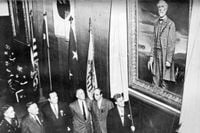On August 29, 2025, the Pentagon ordered the reinstallation of a portrait of Confederate General Robert E. Lee in the library at the United States Military Academy at West Point, reigniting a national debate over how the United States remembers its most divisive figures. The painting, which had hung in the library for 70 years, was removed in 2022 following a survey by the Naming Commission, but is now set to return under the revived instructions of President Donald Trump’s administration, according to The New York Times and The Independent.
The portrait in question is no ordinary piece of art. Painted by Sidney Dickinson in 1951, it depicts Lee resplendent in the gray uniform of a Confederate general, complete with yellow piping and three stars in a wreath on his collar—signifying his rank as a general of the Confederate States of America. In the background, a Black man, believed by some to represent an emancipated servant, guides Lee’s horse, Traveller. The image itself has become a flashpoint in the broader debate over Confederate symbols and how the nation chooses to honor, or not honor, its complex past.
The decision to reinstall the portrait follows a pattern of actions by the Trump administration to restore Confederate memorials and names that had been removed or changed during the Biden administration. As noted by The Independent, President Trump has moved to reverse several decisions, including restoring the names of military bases that had honored Confederate leaders. At a speech in Fort Bragg, North Carolina, Trump criticized Congress’s 2020 directive, calling it a "politically motivated attempt to wash away history and to dishonor the immense progress our country has fought for in realizing our founding principles."
Rebecca Hodson, communications director for the Army, told The New York Times, "Under this administration, we honor our history and learn from it—we don’t erase it." This sentiment echoes the administration’s approach to other Confederate memorials and artifacts, positioning the restoration as an act of historical preservation rather than celebration.
But the return of Lee’s portrait is far from a straightforward act of honoring history. Robert E. Lee, a West Point graduate and superintendent of the academy from 1852 to 1855, resigned from the U.S. Army after the outbreak of the Civil War and became the Confederacy’s most successful general. The Confederacy, as The New York Times and The Independent both emphasize, was formed explicitly to preserve the institution of slavery. In an 1856 letter, Lee wrote, "Slavery was a greater evil to the white than to the black race, & while my feelings are strongly interested in behalf of the latter, my sympathies are more strong for the former. The blacks are immeasurably better off here than in Africa, morally, socially & physically. The painful discipline they are undergoing, is necessary for their instruction as a race, & I hope will prepare & lead them to better things."
For many Americans, especially Black Americans, the Confederacy and its leaders, including Lee, represent a legacy of oppression and violence. As The Independent points out, millions of Black people were bought and sold as property, abused, and forced into labor—the very system the Confederacy fought to protect. The decision to reinstall Lee’s portrait at West Point, an institution that trains future U.S. military leaders, raises pointed questions about the values being upheld and the messages being sent to cadets and the broader public.
The history of Lee’s commemoration at West Point is itself a study in shifting national attitudes. According to historian Ty Seidule, who served as vice chair for the Naming Commission and wrote extensively on the subject, West Point avoided honoring Lee or other Confederates throughout the 19th century. The academy and the nation blamed West Point for its graduates’ decisions to fight against the United States. It wasn’t until the early 20th century, amid efforts at sectional reconciliation following the Spanish-American War, that figures like former Confederate General James Longstreet were invited to participate in West Point celebrations. In 1931, the United Daughters of the Confederacy (UDC) donated plaques and a portrait of Lee in his U.S. Army uniform, though the Army initially refused to allow a depiction of Lee in Confederate gray.
The portrait at the center of today’s controversy was commissioned in 1951 by Secretary of the Army Gordon Gray, intended to "symbolize the end of sectional difference" after World War II. Its installation coincided with fraught debates over racial integration in the military. The Korean War had forced the Army to integrate, but not without significant resistance from military leadership. As Seidule notes, "The military has trumpeted its role in bringing racial equality to America, but the history is far more complex and less flattering." The placement of Lee’s portrait during this period reflected not just a desire for reconciliation but also the racial tensions of the era.
The painting was displayed opposite a portrait of Ulysses S. Grant, the Union general who accepted Lee’s surrender at Appomattox in 1865, ending the Civil War. The juxtaposition of the two portraits in the West Point library seemed to embody the country’s ongoing struggle with its Civil War legacy—a struggle that persists to this day.
Recent years have seen a surge in efforts to reconsider Confederate symbols, especially following the deadly 2017 white nationalist rally in Charlottesville, Virginia, which was sparked by plans to remove a statue of Lee. Congress’s 2020 mandate required the Department of Defense to remove all names, symbols, monuments, and paraphernalia that honored the Confederacy. The Biden administration oversaw the renaming of bases such as Fort Lee, which became Fort Gregg-Adams in honor of African American veterans. But with Trump’s return to the White House, these changes are being rolled back.
The Trump administration’s focus on restoring Confederate memorials has drawn criticism from those who see it as an attempt to whitewash history and downplay the realities of slavery. According to The New York Times, the administration has also sought to "purge museums of accurate depictions of slavery and minority achievements." President Trump himself recently complained that the Smithsonian museums focus too much on "how bad slavery was." For critics, the restoration of Lee’s portrait is emblematic of a broader effort to recast America’s racial history in a more favorable light for those who wish to honor the Confederacy.
The controversy has also been fueled by the Pentagon’s decision to hold a military funeral for Ashli Babbitt, the Air Force veteran killed during the January 6, 2021 riot at the Capitol. Babbitt has been elevated by some on the right as a martyr, drawing a parallel with the efforts to honor Lee. Both figures, critics argue, are being held up as moral exemplars for West Point and other military academies, despite their roles in opposing the United States government.
As the Lee portrait returns to West Point, the debate over how America remembers its past—warts and all—remains as heated as ever. The portrait’s reinstallation is not just about a painting or a general, but about who gets to shape the nation’s memory and whose stories are elevated or erased.
In this latest chapter, the walls of West Point’s library once again reflect a nation still wrestling with the legacy of its most painful divisions, and the meaning of honor in the American story.



